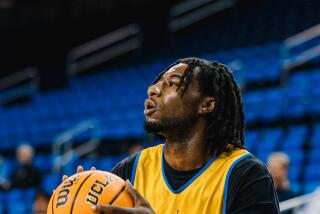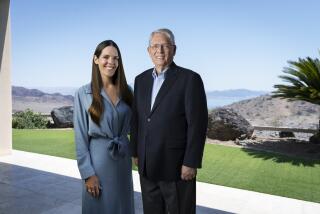Cancer survivor John Vallely steps beyond recovery
For most longtime Los Angeles sports fans, John Vallely is in the category of “whatever happened to …”
And so, we shall tell you.
He was the Bruins’ basketball beach boy, the kid from Corona del Mar High School whom John Wooden blended nicely with his big-city recruits, one of them named Lew Alcindor. Vallely was 6 feet 2 and could shoot like a dream.
On UCLA’s NCAA title teams of 1969-70, Vallely was the Bruins’ outside threat, the guy who had Wooden’s blessing to fire almost at will. Had he played somewhere else, he might have had Pete Maravich numbers, at least in the category of shots attempted.
In UCLA’s ’69 title run, the junior Vallely had 29 points in the semifinal victory and 15 in the final. The next season’s title, achieved after Alcindor (Kareem Abdul-Jabbar) departed for the Milwaukee Bucks, included 23 points from Vallely in the semifinals and 15 in the final.
A first-round draft choice, he had a couple of cups of coffee in the NBA, then returned to Newport Beach and started some businesses. By then, Vallely was a “former,” and with the passage of years, a “whatever happened to …”
Now, age 63, he sits in the manicured backyard of his home in a beautiful section of Newport Beach (is there any other kind?) and says, “I don’t recommend the journey I have had.”
He married the woman he met at Orange Coast College. When he asked where she would like to go on their third date and she said, “The library, where it is quiet and we can get something done,” he was willing, but unsure. “What’s the library,” he said.
Obviously, the challenge for the future Karen Vallely was large, but soon Vallely’s grades had improved enough for him to get offers from places such as UCLA.
When he was headed off to play in the NBA, he asked Karen whether she’d like to come along and live with him. He still hadn’t learned.
“Is that your best offer?” she responded.
So they got married, started a life and had two kids, Eric and Erin. So far, so good.
In 1988, their daughter Erin, 9, was diagnosed with a rare form of cancer of the soft muscle tissue. It was potentially fatal. One of their friends had a child diagnosed with the same form of cancer at the same time. That child survived.
“Erin fought like a warrior,” Vallely says. “It was wrenching. On one trip home from the hospital, she asked me whether she would live until Christmas.”
She didn’t. She died in September 1991.
Vallely’s magical Mamas & Papas’ life of California Dreamin’ — the beach and sunshine and sports heroics and financial success — descended into dark clouds. He says he sleepwalked through the ensuing days, weeks and months and now says he is both proud and amazed at how well his son, Eric, now 36, stayed together while having to handle some of his teenage life without an engaged father. Eric went on to star in volleyball at UCLA.
In 2003, a new storm blew in. Vallely himself was diagnosed with cancer, non-Hodgkins lymphoma, also potentially fatal. He lost weight, strength, desire. He had one stem cell treatment that didn’t work. Then, after much despair, another was offered, after a search of a worldwide bank of donors.
“You have to get an almost exact match,” he says. “For me, there were more than 100. I’m like a mutt.”
The closest match came from a young soldier deployed in Iraq. He was certainly not available. The second-closest came from a winemaker named Richard Hofmeister, who lived about two hours outside Frankfurt, Germany. The man had gotten into the donor bank when a child in a nearby village was ill and a call went out to surrounding towns.
This time the procedure worked, and after a two-year waiting period, Vallely was able to find out who his stem cell donor was. He wrote to Hofmeister, found out he was coming to Connecticut to visit his daughter, and traveled to meet him.
“We knocked on the door,” Vallely says. “His daughter answered, and he was standing behind her. I walked right in, gave him a hug and told him, ‘You’ve given me the gift of life.’”
That could be the end of the story, a somewhat happy one, even with the loss of Erin. Vallely has been cancer-free almost six years.
“Getting to that five-year mark is a big deal,” he says.
But Vallely has not taken his ball and gone home. That never was his style, not at UCLA when the game mattered. Not now.
He has become the driving force in a program called Dribble for the Cure. On Oct. 30, on UCLA’s campus, they will hold the fourth annual. The men’s team of Ben Howland and the women’s team of Cori Close will be there to dribble around campus with thousands of people who gather sponsors for the cause. Half the funds go to the Mattel Children’s Cancer Research Center at UCLA and the other half to the Pediatric Cancer Research Foundation, of which Vallely is a board member.
Last year, one young cancer patient in a wheelchair, Derrek Cordova, raised $8,405 himself and one team raised $13,000. About $100,000 was raised, and Vallely wants more this year.
Despite what he has been through, little has changed. The game is on the line for thousands of children with cancer, and John Vallely has the ball in his hands.
More to Read
Go beyond the scoreboard
Get the latest on L.A.'s teams in the daily Sports Report newsletter.
You may occasionally receive promotional content from the Los Angeles Times.











